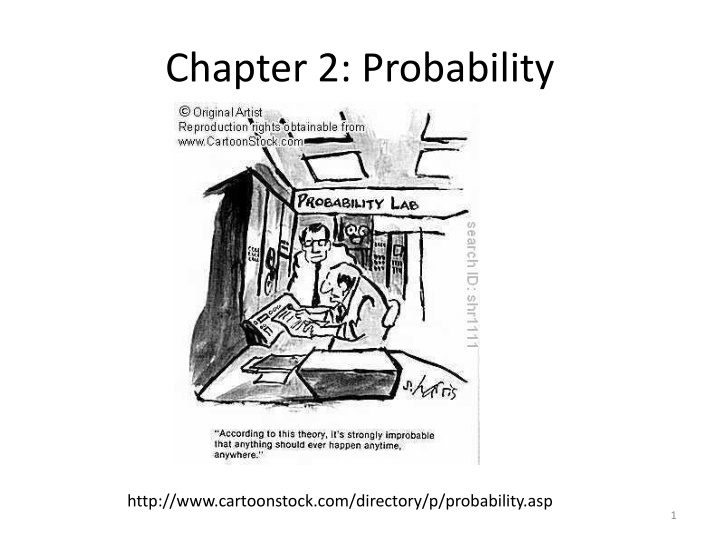
Probability in Chapter 2 with Theorems and Examples
Explore the concepts of probability in Chapter 2, including the frequentist interpretation, axioms, theorems, and examples. Learn about disjoint events, nonnegativity, certainty, additivity, and more. Dive into legitimate probabilities of sample spaces and the inclusion/exclusion rule. Discover how to calculate probabilities in various scenarios with practical examples.
Download Presentation

Please find below an Image/Link to download the presentation.
The content on the website is provided AS IS for your information and personal use only. It may not be sold, licensed, or shared on other websites without obtaining consent from the author. If you encounter any issues during the download, it is possible that the publisher has removed the file from their server.
You are allowed to download the files provided on this website for personal or commercial use, subject to the condition that they are used lawfully. All files are the property of their respective owners.
The content on the website is provided AS IS for your information and personal use only. It may not be sold, licensed, or shared on other websites without obtaining consent from the author.
E N D
Presentation Transcript
Chapter 2: Probability http://www.cartoonstock.com/directory/p/probability.asp 1
Frequentist Interpretation 0.8 Proportion of Hearts 0.6 Trial 1 0.4 Trial 2 0.2 Trial 3 0 0.25 0 20 40 60 80 100 Number of draws 0.8 Proportion of Hearts 0.6 Trial 1 0.4 Trial 2 0.2 0.25 0 0 200 400 Number of draws 600 800 1000 2
Disjoint Event A and event B are disjoint. Both events A and B cannot occur. Event A and event B have no common outcomes. ? ? = 3
Axioms 2.4 1. Nonnegativity For each event A, 0 P(A) 1 2. Certainty For the sample space, S, P(S) = 1 3. Additivity If A1, is a collection of disjoint events, then ? ?? = ? ?? ?=1 ?=1 4
Theorems Th. 2.5: The probability of the empty set, , is always 0. Th. 2.6: If A1, A2, , An is a collection of finitely many disjoint events, then ? ? ? ?? = ?(??) ?=1 ?=1 5
Example: Legitimate Probabilities of Sample Spaces Row # Outcome #1 #2 #3 #4 #5 #6 1 11 0.0625 0 0.1 0.1 0.05 0.05 2 12 0.0625 0 0.1 0.1 0.05 0.05 3 13 0.0625 0 0.1 0.1 0.05 0.05 4 14 0.0625 0 0.1 0.1 0.05 0.05 5 21 0.0625 0.25 0.1 0.2 0.1 0.1 6 22 0.0625 0.25 0.1 0.2 0.1 0.1 7 23 0.0625 0.25 0.1 0.2 0.1 0.1 8 24 0.0625 0.25 0.1 0.2 0.1 0.1 9 31 0.0625 0 0.1 -0.1 0 0.01 10 32 0.0625 0 0.1 -0.1 0 0.01 11 33 0.0625 0 0.1 -0.1 0 0.01 12 34 0.0625 0 0.1 -0.1 0 0.01 13 41 0.0625 0 0.1 0.05 0.1 0.05 14 42 0.0625 0 0.1 0.05 0.1 0.05 15 43 0.0625 0 0.1 0.05 0.1 0.05 6 16 44 0.0625 0 0.1 0.05 0.1 0.05
Section 2.3: Theorems Complementation Rule: Th. 2.19: P(Ac) = 1 P(A) Domination Principle: Th. 2.20: If A B, the P(A) P(B). 7
Section 2.4 Inclusion/Exclusion (General Addition Rule) Th. 2.22: For any two events A and B, P(A U B) = P(A) + P(B) P(A B) 8
Example 2.26 Consider a student who draws cards from a deck. After he draws the card, he replaces the card and then reshuffles the deck. He stops if he draws the ace of spaces. What is the probability of Bk, when the ace of spaces is found for the first time on the kth draw? 9
Example 2.27 A student hears ten songs (in a random shuffle mode) on her music player, paying special attention to how many of these songs belong to her favorite type of music. We assume the songs are picked independently of each other and that each song has probability p of being a song of the student s favorite type. What is P(Aj) where Aj is the event that exactly j of the 10 songs are from her favorite type of music? 10
